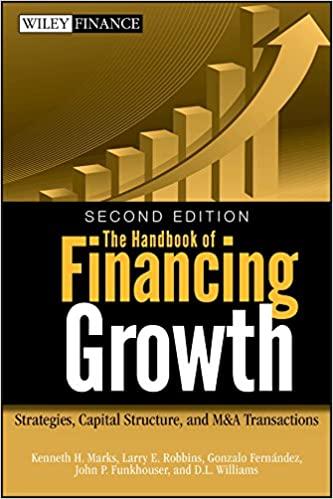Question
Buy vs. Rent In May 2013, Becca completed her MBA and moved to Toronto for her new job in investment banking. There, she rented a
Buy vs. Rent
In May 2013, Becca completed her MBA and moved to Toronto for her new job in investment banking. There,
she rented a 2-bedroom condominium for $3,000 per month, which included parking but not utilities or cable
television. In July 2014, the virtually identical unit next door became available for sale with an asking price of $620,000
and Becca believes that she can purchase it for $600,000. She realized that she was facing a classic buy-versus-rent
decision.
While Becca really liked the condominium unit she was renting, as well as the condominium building itself, she felt
that it maybe inadequate for her long term needs, as she planned to move a house or even to a larger penthouse
condominium in the next 5 - 10 years, or even sooner if her job continued to work out well.
Friends and family have given Becca a variety of mixed opinions concerning the buy-versus-rent debate, ranging
from "you're throwing your money away on rent" or "it's better to keep things as cheap and flexible as possible until
you are ready to settle in for good". She realized that both sides presented good arguments, but she wanted to
analyze the buy-versus-rent decision from the quantitative point of view in order to provide some context for the
qualitative considerations that would ultimately be a major part of her decision.
Financial Details
If Becca purchased the new condominium, she would pay monthly condo fees of $1,055 per month, plus property
taxes of $300 per month on the unit. Unlike when renting, she would also be responsible for repairs and general
maintenance, which she estimated would average $600 per year.
If she decided to purchase the new unit, Becca intended to provide a cash down payment of 20% of the purchase price. There was also a local deed-transfer tax of approximately 1.5% of the purchase price, and a provincial deed-transfer tax of 1.5%, both due on the purchase date. (For simplicity, Becca planned to initially ignore any other tax considerations throughout her analysis.) Other closing fees were estimated to be around $2,000.
Scenario
In order to complete a financial analysis of the buy-versus-rent decision, Becca realized that her first task would be
to determine the required monthly mortgage payments. Next, she wanted to determine the opportunity costs (on a
monthly basis) of using the lump-sum required funds for the condominium purchase rather than leaving those funds
invested and earning the effective monthly rate, assumed to be equivalent to the mortgage rates. She would then be
able to determine the additional monthly payments required to buy the condominium compared to renting, including
the opportunity cost.
Becca wanted to consider what might happen if she decided to sell the condominium at a future date. She was
confident that any resell would not happen for at least two years, but could certainly happen in the next 5 or 10 years'
time. She needed to model the amount of the outstanding principal at various points in the future -- 2 years, 5 years, or
10 years from now. She then wanted to determine the net future loss or gain after 2 years, 5 years, or 10 years under
the following scenarios, which she had determined were possible after some due diligence regarding the future real
estate prices in the Toronto Condo Market:
(a) the condo price remains unchanged
(b) the condo price drops 10% over the next 2 years, and then increases back to the purchase price by end of 5 years,
and then increases by 10% from the original purchase price at the end of 10 years
(c) the condo price increases annually by the annual rate of inflation at 2% per year over the next 10 years
(d) the condo price increases annually by an annual rate of 5% per year over the next 10 years
Answer these 6 guide questions by putting the concepts used, step by step computations, and final answer. You can also use a table / illustration for comparison purposes
1. Determine the required monthly payments for the mortgage.
2. Determine the "opportunity" costs, on a monthly basis, of using the required funds for closing (i.e. down payment +
all closing costs), rather than leaving those funds invested and earning the monthly effective rate determined in part
(a).
3. Determine the monthly additional payments required to buy versus rent, include the monthly opportunity costs
determined in part (b).
4. Determine the principal outstanding on the mortgage after:
(a) 2 years
(b) 5 years
(c) 10 years
5. Determine the "net" future gain or loss after 2 years, 5 years, and 10 years under the following scenarios, which
Becca has determined as possible after some "due diligence" regarding future real estate prices in the
Toronto condo market:
(a) the condo price remains unchanged
(b) the condo price drops 10% over the next 2 years, and then increases back to the purchase price by end of 5
years, and then increases by 10% from the original purchase price at the end of 10 years
(c) the condo price increases annually by the annual rate of inflation at 2% per year over the next 10 years
(d) the condo price increases annually by an annual rate of 5% per year over the next 10 years
Step by Step Solution
There are 3 Steps involved in it
Step: 1

Get Instant Access to Expert-Tailored Solutions
See step-by-step solutions with expert insights and AI powered tools for academic success
Step: 2

Step: 3

Ace Your Homework with AI
Get the answers you need in no time with our AI-driven, step-by-step assistance
Get Started


